Evaluation of Mechanical Properties, Color Stability, and Cleaning Efficacy of BioMed Clear Resin-Based Dental Aligners
Funding: This study was financially supported by Universiti Teknologi Malaysia (grant no: Q.J130000.3023.04M13) and Klinik Pergigian Angkasa Sri Rampai (grant no: R.J130000.7651.4C615).
ABSTRACT
Clear aligners have gained widespread popularity as a comfortable and aesthetically appealing alternative to traditional braces; however, there is a lack of comprehensive research on the interplay between aligner thickness, color stability, and cleaning efficacy. This study addresses these gaps by systematically assessing the mechanical strength, color stability, and cleaning efficiency of BioMed Clear resin-based aligners fabricated at different thicknesses. Seven aligner thicknesses, ranging from 0.50 to 1.10 mm, were designed and 3D-printed using advanced scanning technologies. Mechanical compression testing revealed significant differences in compressive strength based on aligner thickness (p < 0.05), with the 0.60 mm thickness demonstrating optimal resistance. To assess color stability, aligners were exposed to stain solutions, where turmeric induced the most pronounced discoloration. Cleaning efficacy experiments indicated that gargling was the most effective agent for stain removal. These findings provide valuable insights into the optimization of aligner thickness for enhanced mechanical performance and patient comfort. Furthermore, the study highlights effective cleaning strategies to maintain oral hygiene and aligner aesthetics during orthodontic intervention. This research contributes to the advancement of aligner design and fabrication, offering evidence-based recommendations for improving clinical outcomes in orthodontic practice.
1 Introduction
The field of orthodontics has undergone significant progress with the emergence of clear aligners, offering an innovative and aesthetically appealing solution for correcting malocclusion, commonly referred to as misaligned teeth [1, 2]. Unlike traditional braces, clear aligners provide a discreet treatment option that combines transparency, enhanced comfort, and convenience. Their growing popularity is largely attributed to their ability to improve both oral health and self-esteem, making them a preferred choice for patients and clinicians alike [3].
Malocclusion, characterized by the improper alignment of teeth and jaw, poses a range of challenges, from aesthetic concerns to functional impairments. While genetic factors play a dominant role in its occurrence, environmental factors such as oral habits and injuries also contribute [4-6]. If left untreated, malocclusion can lead to complications such as altered speech, masticatory inefficiency, periodontal issues, and temporomandibular joint dysfunctions, thereby impacting an individual's overall quality of life [7, 8]. Early diagnosis and intervention significantly improve treatment outcomes, making corrective procedures beneficial for individuals of all ages [9]. Historically, traditional braces have been the primary treatment method for malocclusion; however, the rise of clear aligners as an alternative has transformed the orthodontic landscape by providing a more discreet and patient-centric approach [5, 10].
The evolution of clear aligners has been driven by advancements in dental technology, particularly the integration of digital workflows and three-dimensional (3D) printing techniques. These technological innovations have revolutionized aligner fabrication, enabling precise customization of aligners to meet individual patient needs and enhancing their functionality [9]. Among these customizations, optimizing aligner thickness has emerged as a crucial factor in ensuring effective tooth movement and mechanical durability. However, the mechanical resilience of aligners under everyday forces and their susceptibility to discoloration caused by staining agents remain inadequately explored in the existing literature [11].
This study aims to address these knowledge gaps by providing a comprehensive evaluation of BioMed Clear resin-based dental aligners, focusing on three critical aspects: mechanical properties, color stability, and cleaning efficacy. BioMed Clear resin, a biocompatible material commonly used in 3D printing processes, has shown promise in orthodontic treatments due to its strength and aesthetic qualities [12, 13]. Assessing the mechanical strength of aligners with varying thicknesses is essential for determining optimal designs capable of withstanding the mechanical stress of daily wear. Similarly, evaluating aligner color stability when exposed to common staining agents and investigating the effectiveness of cleaning agents in maintaining their transparency are crucial for ensuring patient satisfaction and adherence to treatment protocols.
By bridging the gap between materials science, orthodontics, and advanced manufacturing technology, this research seeks to provide a comprehensive understanding of the functional and aesthetic performance of clear aligners. The findings are expected to assist practitioners and manufacturers in optimizing aligner design, materials, and maintenance protocols, thereby enhancing their reliability and patient outcomes. Furthermore, this study contributes to the broader field of dental materials by informing the development of next-generation biocompatible materials and manufacturing techniques. Ultimately, the insights gained from this research aim to advance the application of clear aligners in orthodontic therapy, improving both clinical practice and the scientific understanding of dental materials.
2 Materials and Methods
2.1 Subject Recruitment and Dentition Scanning
Two subjects were recruited for this study to represent diverse dental conditions, including one individual with interdental spacing (gapped teeth) and another with dental crowding. Subject selection adhered to strict inclusion criteria designed to obtain a representative range of orthodontic cases. All participants provided written informed consent before enrollment, and the study was conducted in compliance with the ethical guidelines outlined in the Declaration of Helsinki and the National Institutes of Health guidelines issued by the Ministry of Health Malaysia. Ethical approval for the study was obtained from the relevant institutional review board.
Dental scanning was performed using a Smooth 3D dental scanner, a high-precision device commonly used in orthodontic research to create accurate 3D models of dentition [10]. To ensure consistent and reliable scan quality, subjects were seated in a stable position to minimize any apparent motion during the procedure. The digital scanner was interfaced with a laptop and dedicated computer software, which facilitated real-time visualization of the scanned areas and guided the operator through the scanning process. The software's advanced features ensured comprehensive coverage of all dental surfaces, reducing the risk of incomplete data acquisition.
Upon completion of the scanning process, the 3D models of the subjects' teeth were exported in stereolithography (STL) format. This file format was chosen for its compatibility with advanced 3D printing and design software, enabling seamless integration into subsequent aligner design and analysis workflows. The STL data file served as the foundational data for the design and production of the BioMed Clear resin-based aligners evaluated in this study.
2.2 Aligner Modeling
The scanned STL files of the subjects' dentition were used as the foundational data for the design of clear aligners using advanced computer-aided design/computer-aided manufacturing (CAD/CAM) techniques [14]. This workflow ensured precision in aligner fabrication, adhering to established orthodontic standards. The process began with loading the STL files into specialized CAD software, where vital pre-processing steps were performed. These steps included identifying and marking missing teeth, analyzing arch length variance, and delineating the teeth-dentition boundaries, all of which are essential for the accurate design of aligners [15].
To refine the raw data, the files underwent meticulous editing in 3-Matic, a software renowned for its capabilities in dental and biomedical modeling. This editing phase involved removing extraneous artifacts, bridging any gaps in the scanned data, and ensuring the generation of smooth curves along the aligner's boundaries to optimize both functionality and patient comfort. Following the editing process, aligner thickness was incrementally adjusted to produce seven variations: 0.50, 0.60, 0.70, 0.80, 0.90, 1.00, and 1.10 mm. These thickness variations were selected to systematically evaluate the mechanical performance and aesthetic properties of the aligners under different conditions.
The finalized STL files for each aligner model were imported into Anycubic Photon Workshop software, a specialized program for 3D printing workflows. Within this software, structural supports were added to each model to facilitate stable and accurate 3D printing, as illustrated in Figures 1 and 2. The addition of supports ensured the precision of the printing process and minimized the risk of defects during fabrication.


2.3 3D Printing and Post-Processing
The aligners were 3D printed using an Anycubic Photon Workshop stereolithography (SLA) printer, utilizing BioMed Clear resin (FormLabs, USA) (see Figure 3a,b). The use of BioMed Clear is due to the fact that it is a medical-grade material designed for hard, strong material for biocompatible applications requiring long-term skin or mucosal membrane contact as stated in the guidelines from FormLabs company. It can be sterilized by autoclave, E-beam, gamma, and ethylene oxide all together are very technically supporting towards the medical devices' application. Support structures were added to the models within the software to ensure accurate printing [16]. Printed aligner models were cleaned with 99.9% isopropyl alcohol (IPA) for 10 min to remove the uncured resin, then air-dried. Post-cure treatment was performed in a UV-light chamber for 20 min at 30°C for optimal material polymerization and biocompatibility [17] as presented in Figure 4. The support structures of the aligners were then removed using standard cutting tools [12].
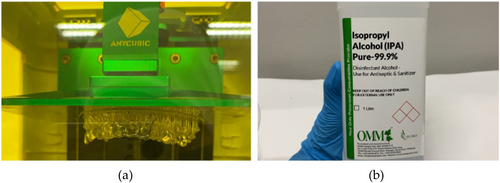
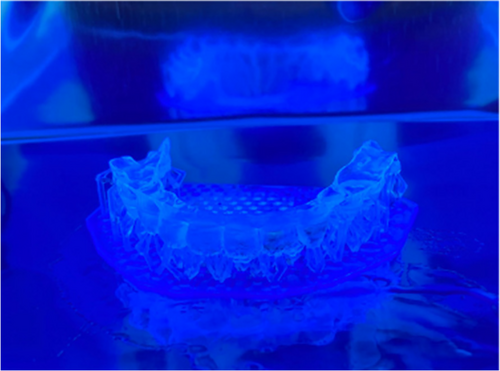
2.4 Finite Element Analysis
Finite element analysis (FEA) was performed prior to laboratory mechanical testing to evaluate the structural integrity and performance of the dental aligners under simulated conditions. The 3D aligner model was imported into Marc.Mentat software (MSC Marc, USA), a specialized tool for nonlinear FEA commonly used in biomedical applications. The material properties of BioMed Clear resin were specified with a Young's modulus of 2.8 MPa and a Poisson's ratio of 0.4 to ensure realistic simulation results. Boundary conditions were applied, with a vertical force of 0.1 N exerted on the outer surface of the aligner to simulate orthodontic forces during use, while the inner surface interfacing with the dentition was constrained in a fixed position to replicate its stability.
2.5 Mechanical Testing
The mechanical properties of the dental aligners were evaluated using a universal testing machine (Instron, USA) to assess their compressive strength as shown in Figure 5. Each aligner, with varying thicknesses, was subjected to a compression load of up to 1000 N, which exceeds the average maximum biting force of approximately 756 N reported in the literature [12, 16]. The aligner specimens were securely positioned between two parallel flat plates of the Instron machine using a custom-designed jig. This jig was created using 3-Matic software and 3D printing to ensure precise alignment and stability during the testing process. The compression test was conducted at a rate of 2 mm/min, and both the compressive load (in N) and compressive extension (in mm) were recorded for subsequent analysis. Statistical analysis was performed using one-way analysis of variance (ANOVA) to assess significant differences between the aligners of different thicknesses [17].
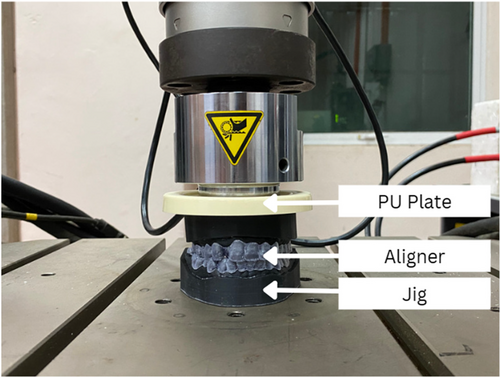
2.6 Color Stability and Transparency Testing
To evaluate the color stability and transparency of BioMed Clear resin-based clear aligners, a systematic approach was employed using a set of colorant solutions presented in Figure 6a and 6b. The coloring solutions were prepared by dissolving 3 g of coffee, 3 g of turmeric, and one tea bag (2 g) in 100 mL of warm distilled water, as outlined in previous studies [18]. The aligner specimens were then exposed to four different coloring agents: turmeric, coffee, tea, and warm distilled water, which served as a control solution. The purpose of the control solution was to establish a baseline for comparison and to monitor the inherent transparency of the aligner material without the influence of staining agents.
Each aligner specimen was carefully immersed in its respective coloring solution and placed in an incubator set at 37°C to simulate the physiological conditions of the human mouth [19]. The aligners were submerged in the solutions for a total of 3 days to allow sufficient exposure time to the colorants. To ensure consistency and accuracy in the experimental conditions, the coloring solutions were refreshed daily, maintaining a controlled and consistent environment for the duration of the testing period.
After 3 days of immersion, the color changes and transparency alterations of the aligner specimens were quantitatively measured using a UV–Visible spectrometer. The spectrometer, which measured light transmittance across a spectrum of wavelengths from 380 to 780 nm [20], was employed to detect changes in the optical properties of the aligners. This enabled the precise determination of any alterations in color stability and transparency induced by exposure to the various coloring agents. The inclusion of the control solution allowed for a comparative assessment of the color changes, ensuring that the effects of the staining agents could be accurately evaluated.
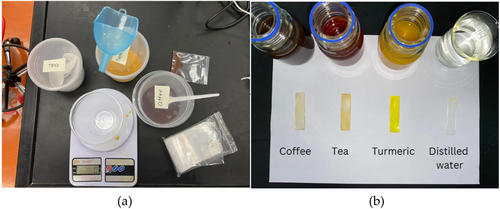
2.7 Effectiveness of Cleaning Agents Testing
The cleaning efficacy of different agents on stained BioMed Clear resin-based aligners was evaluated using three distinct cleaning solutions: mouthwash, retainer and guard cleaner, and 3% hydrogen peroxide (H2O2), as shown in Figure 7. The objective was to assess the ability of these cleaning agents to restore the transparency of the aligners after exposure to staining agents. For this experiment, the least transparent aligner sample from the color stability and transparency tests was selected for further cleaning efficacy testing.

The cleaning procedure involved immersing the stained aligner samples in the respective cleaning solutions for a predetermined duration of 10 min. For the retainer and guard cleaner, the cleaning duration was limited to 3–5 min, in accordance with the manufacturer's instructions provided on the packaging. To ensure uniform exposure and facilitate the cleaning process, the cleaning solutions and aligner specimens were gently stirred during the treatment. After the prescribed cleaning time, the aligner samples were air-dried to remove any excess solution before subsequent transparency analysis.
Following the cleaning process, the transparency of each aligner was quantitatively assessed using a UV–Visible spectrometer, which measured light transmittance across a wavelength range from 380 to 780 nm [20]. This measurement provided a precise evaluation of the aligner's transparency, which serves as an indicator of the cleaning agent's effectiveness in removing surface stains and maintaining the material's optical integrity.
3 Results
3.1 Finite Element Analysis
Figure 8 shows the result of the simulation in terms of displacement. It is found that central incisor teeth experience the highest displacement at 0.001893 mm compared to another tooth. To be noted, the displacement is relatively small and no significant effects to the position of the aligner on the tooth. Apart from that, the stress was found to be highest at the same point in Figure 8, with the value of 8.256 × 10−5 MPa.
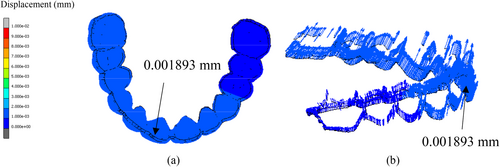
3.2 Compressive Testing
To evaluate the mechanical properties of BioMed Clear resin-based dental aligners, compressive testing was conducted on aligners with varying thicknesses, specifically 0.5, 0.6, 0.7, 0.8, 0.9, 1.0, and 1.1 mm. A controlled compressive load of 1000 N was systematically applied to each aligner, across both subject groups, in order to assess their resistance to compressive forces. During the compressive testing, data were collected to monitor both the applied compressive load (in Newtons) and the corresponding compressive extension (in millimeters). These data provided insight into the material's deformation behavior under compressive stress, which is crucial for understanding the aligner's performance during orthodontic treatment. The results were analyzed to determine the relationship between the aligner's thickness and its mechanical resilience, with particular attention to the alignment's ability to withstand pressure while maintaining its structural integrity.
3.2.1 Statistical Analysis
To analyze the data collected during the compressive testing of BioMed Clear resin-based dental aligners, a one-way ANOVA was performed to evaluate potential differences among the various aligner thicknesses. The primary objective of this statistical analysis was to determine whether significant variations in mean values existed between the different thickness groups. ANOVA was employed to assess the null hypothesis that there is no significant difference in the means of the groups and to identify whether any differences in compressive load and extension behavior could be attributed to aligner thickness. The p-values derived from the ANOVA were used to assess the significance of the differences observed between the groups. A p-value of less than 0.05 was considered to indicate a statistically significant difference between the tested groups. The results of the ANOVA for both subjects are presented in Tables 1 and 2, which detail the model, error, and total sums of squares, mean squares, F-values, and the corresponding p-values.
| df | Sum of squares | Mean square | F value | Prob > F | |
|---|---|---|---|---|---|
| Model | 6 | 1781.9486 | 296.99144 | 1132.89916 | < 0.0001 |
| Error | 375,579 | 98,458.6722 | 0.26215 | ||
| Total | 375,585 | 100,240.6208 |
| df | Sum of squares | Mean square | F value | Prob > F | |
|---|---|---|---|---|---|
| Model | 6 | 28,901.48936 | 4816.91489 | 13,642.91502 | < 0.0001 |
| Error | 397,020 | 140,176.16825 | 0.35307 | ||
| Total | 397,026 | 169,077.65762 |
The results from both subjects indicate highly significant differences (p < 0.0001) between the aligner thickness groups, suggesting that the thickness of the aligners plays a crucial role in their compressive performance. This statistical finding emphasizes the importance of thickness selection in optimizing aligner durability and effectiveness in orthodontic treatments. The observed differences in the mechanical properties of the aligners can be attributed to variations in their material characteristics, which directly influence their ability to withstand compressive forces.
3.2.2 Results and Interpretation
For Subject 1, who presented with gapped front teeth, the one-way ANOVA revealed a p-value below 0.05, thereby rejecting the null hypothesis and confirming the existence of significant differences in the means across the various aligner thickness groups. However, contrary to the anticipated trend, the means of the different thickness groups exhibited inconsistencies. These inconsistencies may be attributed to potential shifts in the positioning of the test jigs under compressive load, possibly caused by the irregular arrangement of the teeth. Such misalignments during testing likely contributed to the observed variability in results. To further explore these discrepancies, post hoc testing was performed using the Tukey test, which identified pairs of thickness groups that shared common letters, indicating similar mean values. The Tukey test results for Subject 1 are summarized in Table 3, where it is evident that aligners with thicknesses of 0.7 and 1.1 mm had nearly identical means, suggesting comparable mechanical strength. Additionally, the 0.6 mm thickness group displayed a lower compressive extension mean compared to other thicknesses, indicating that this group exhibited superior mechanical strength. This is visually represented in Figure 9, where the compressive extension values are plotted against thickness.
| Mean | Groups | ||||||
|---|---|---|---|---|---|---|---|
| 1.0 mm | 0.9788 | A | |||||
| 0.5 mm | 0.9445 | B | |||||
| 0.8 mm | 0.8769 | C | |||||
| 0.7 mm | 0.8496 | D | |||||
| 1.1 mm | 0.8433 | D | |||||
| 0.9 mm | 0.7979 | E | |||||
| 0.6 mm | 0.7759 | F | |||||
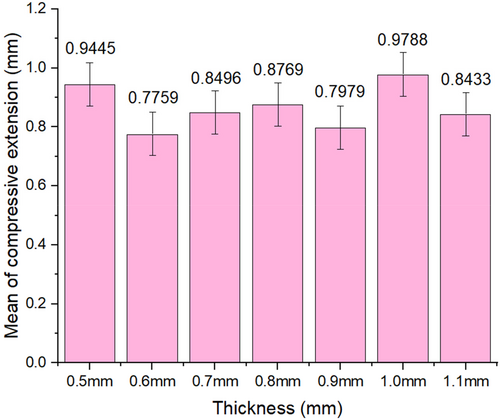
For Subject 2, characterized by crowded teeth, the ANOVA analysis also yielded a p-value below 0.05, which indicates statistically significant differences in the means of the various thickness groups. The Tukey test results for Subject 2, shown in Table 4, revealed which thicknesses shared common letters, signifying similar mean values, and highlighted significant differences among other thickness groups. Despite the expectation that thicker aligners would exhibit lower compressive extension, the results were again inconsistent. This variability may have resulted from human error during testing, leading to uneven force distribution across the aligners, as illustrated in Figure 10.
| Mean | Groups | ||||||
|---|---|---|---|---|---|---|---|
| 0.9 mm | 1.2924 | A | |||||
| 0.5 mm | 1.2894 | A | |||||
| 1.1 mm | 1.0188 | B | |||||
| 0.6 mm | 0.8795 | C | |||||
| 0.7 mm | 0.6828 | D | |||||
| 0.8 mm | 0.6486 | E | |||||
| 1.0 mm | 0.6293 | F | |||||

Upon examining the results across both subjects, the 0.6 mm thickness consistently demonstrated lower compressive extension values, indicating superior mechanical strength compared to the other thickness groups. This suggests that the 0.6 mm aligner thickness provides an optimal balance between material strength and flexibility. Based on these findings, the 0.6 mm thickness is deemed the most suitable for BioMed Clear resin-based dental aligners, offering the best performance in terms of compressive resistance and mechanical integrity under typical orthodontic loading conditions. Further studies incorporating advanced computational models, such as FEA, could help refine these findings and offer more precise recommendations for aligner thickness selection.
3.3 Color Stability and Transparency Testing
Transparency analysis of BioMed Clear resin-based dental aligners was conducted using a UV–visible spectrometer. Samples with dimensions of 50.8 mm × 12.7 mm × 1.0 mm were subjected to testing, and the resulting transmittance (T%) versus wavelength (nm) graphs provided insights into the material's optical properties. The analysis revealed that turmeric-stained samples exhibited the lowest light transmittance at 72.83%, indicating the highest level of opacity among the tested staining solutions. In comparison, coffee-stained samples demonstrated slightly higher transparency, showing a transmittance of 85.90%, while tea-stained samples had the highest transmittance at 88.95%. These findings suggest that the type of staining solution used can significantly affect the transparency of BioMed Clear resin-based dental aligners, with tea causing the least discoloration and turmeric causing the most. As presented in Table 5, the transmittance values for each staining solution were recorded, highlighting the disparities in light transmittance between the different coloring agents. Tea exhibited the highest transparency, followed by coffee, while turmeric resulted in the lowest transmittance, which indicates a more pronounced reduction in optical clarity.
| Coloring solution | Transmittance (T%) |
|---|---|
| Coffee | 85.90 |
| Turmeric | 72.83 |
| Tea | 88.95 |
The color stability of the BioMed Clear resin-based dental aligners was also evaluated by exposing the samples to staining solutions of tea, coffee, and turmeric for a period of 3 days. The results, summarized in Table 6, show that the aligners stained with turmeric exhibited the most significant color changes over the 3-day period. On Day 1, all stained samples showed some degree of discoloration, with turmeric causing the most pronounced shift in color. By Day 2, coffee and tea samples had slightly stabilized in terms of color change, but the turmeric-stained samples continued to darken. On Day 3, the discoloration in the turmeric-stained samples remained the most severe, confirming its tendency to induce the highest degree of color change. As shown in Figure 11, the graph of transmittance (%) versus wavelength (nm) for the staining process clearly illustrates the differences in light transmittance across the different staining solutions. The data confirm that turmeric causes the most significant reduction in transparency, while tea and coffee have a more minimal effect.
| Day 1 | Day 2 | Day 3 | |
|---|---|---|---|
| Distilled water |  |
 |
 |
| Tea |  |
 |
 |
| Coffee |  |
 |
 |
| Turmeric |  |
 |
 |
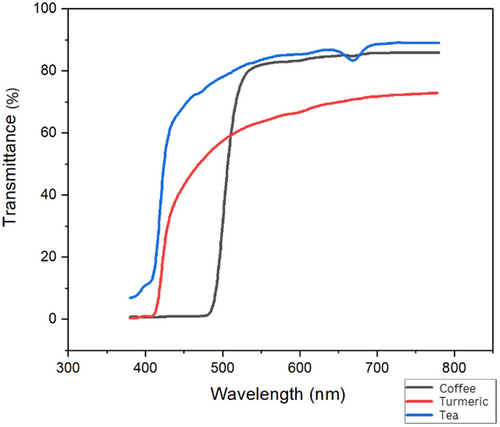
3.4 Effectiveness of Cleaning Agents Testing
To evaluate the efficacy of different cleaning agents, samples stained with turmeric were subjected to cleaning treatments using three distinct agents: mouthwash, retainer & guard cleaner, and 3% hydrogen peroxide (H2O2). The cleaning performance was assessed based on the change in light transmittance (T%) measured by UV–Vis spectrometry. The results revealed that mouthwash was the most effective cleaning agent, significantly improving the transparency of the turmeric-stained samples. Specifically, the light transmittance for mouthwash-cleaned samples was recorded at 89.51%, showing a 16.68% improvement compared to the initial transmittance of the turmeric-stained samples.
However, despite this significant improvement in transparency, visual inspection indicated that some stains remained visible, suggesting that the cleaning agents were not able to completely remove the turmeric discoloration. This persistent staining could be attributed to the inherent limitations of the material or the staining agents themselves. These findings suggest that, although mouthwash is effective at improving the optical properties of the aligners, further investigation is needed to identify more efficient cleaning solutions that could provide a more thorough removal of stains. Additionally, it may be beneficial to explore the use of Dental LT (long-term) resin, which is specifically designed for dental aligners and may offer enhanced resistance to staining and cleaning challenges compared to the material used in this study. As detailed in Table 7, the transmittance values for the different cleaning agents were recorded, demonstrating that mouthwash had the highest cleaning efficacy. The retainer & guard cleaner and the 3% hydrogen peroxide both showed lower transmittance values of 79.95% and 81.85%, respectively, indicating a lesser degree of improvement in transparency compared to mouthwash.
| Cleaning agents | Transmittance (T%) |
|---|---|
| Retainer and guard cleaner | 79.95 |
| Mouthwash | 89.51 |
| 3% hydrogen peroxide, H2O2 | 81.85 |
The results are visually represented in Figure 12, which shows the transmittance (T%) versus wavelength (nm) for the cleaning agents tested. As shown in the figure, mouthwash-treated samples exhibit the highest transmittance, followed by the samples cleaned with 3% hydrogen peroxide, with the retainer & guard cleaner showing the least improvement in transparency. These results confirm the superior performance of mouthwash in enhancing the clarity of turmeric-stained samples, although additional research is required to fully understand the limitations and potential improvements in cleaning efficacy.
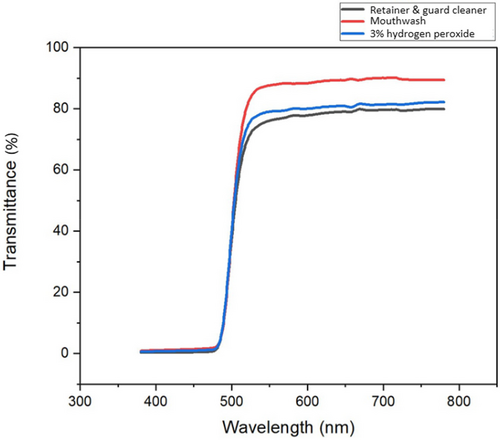
4 Discussion
The field of orthodontics has seen a significant increase in the use of thermoplastic materials, whether as new materials or in combination, due to their promising mechanical strength, flexibility, and ease of cleaning. Materials such as polyurethane (PU), polyethylene terephthalate glycol (PET-G), polyvinyl chloride (PVC), and polyethylene terephthalate (PET) have been widely utilized for aligner fabrication. These materials offer varying properties, including strength, density, tensile stress, and elongation at break, which ultimately influence the performance of dental aligners. Table 8 presents a comparative analysis of BioMed Clear resin, the material used in this study, against other commonly used dental aligner materials.
| Brand | Material | Density (g/cm3) | Elastic modulus (MPa) | Tensile stress (MPa) | Elongation at break (%) |
|---|---|---|---|---|---|
| BioMed Clear (Formlabs Inc.) | Glycol methacrylate | 1.3 | 2100 | 52 | 12 |
| Zendura (Bay Material LLC) | Polyurethane (PU) | 1.203 | — | — | — |
| Biolon (Dreve Dentamid GmbH) | Polyethylene terephthalate glycol (PET-G) | 1.27 | 2020 | 45 | > 35 |
| Biolon (Dreve Dentamid GmbH) | Polyvinyl chloride (PVC) | — | 2200 | 53 | — |
| Biolon (Dreve Dentamid GmbH) | Polyethylene terephthalate (PET) | — | 2050 | 50 | — |
In previous studies, the role of aligner materials in stain resistance has been well established, with the ability to maintain color stability and optical clarity being crucial for both aesthetic and functional purposes. The percentage of light transmittance and color changes on these materials can significantly impact their effectiveness and user satisfaction. Durner et al. [21] demonstrated that Polident material outperformed others in removing tea stains from both smooth and rough specimen surfaces. Similarly, Susarchick et al. [20] found that Invisalign Crystals exhibited superior stain removal capabilities, particularly in comparison to hydrogen peroxide (H2O2) solutions for coffee stain removal. In our study, mouthwash was identified as the most effective cleaning agent for removing turmeric stains from BioMed Clear resin-based aligners. However, visual inspection of the samples (as shown in Table 6) revealed that, despite cleaning, turmeric stains remained visibly persistent on the aligner surfaces, indicating the limitations of current cleaning agents in fully restoring the aligners to their original state.
Regarding the mechanical properties of dental aligners, compression testing is considered one of the most important evaluations to assess their strength, durability, and overall performance. Several studies have investigated the impact of different 3D printing technologies on aligner properties. For example, Zinelis et al. [22] found significant variations in the mechanical properties of aligners fabricated using different 3D printers. Their study, which used five different 3D printers, identified the Slash 2 printer as producing aligners with a superior elastic modulus (2696.3 MPa) compared to other printers. Our study, in contrast, utilized a single 3D printer (Anycubic Photon Workshop stereolithography [SLA] printer), which limits the ability to directly compare our results with those from Zinelis et al. [22]. Nevertheless, the findings from Elshazly et al. [23], who used FEA to assess the displacement of teeth based on aligner thickness, corroborated our own observations. Specifically, Elshazly et al. observed a minimum displacement of 0.2 mm at the tooth when analyzing aligner thicknesses of 0.3, 0.4, 0.5, and 0.6 mm. In our study, a minimum compression extension of 0.6293 mm was recorded for Subject 2, which is consistent with the displacement values observed in the referenced study.
Color stability is another critical factor contributing to the success of clear aligners. Not only does it affect the aesthetic value, but it also plays a crucial role in user satisfaction. Ideally, clear aligners should allow for the transmission of at least 80% of visible light. In this study, however, the turmeric-stained samples showed a light transmittance of 72.83%, which does not meet this ideal threshold, as compared to tea and coffee-stained samples (Table 7). While tea allowed for a higher transmittance (88.95%), coffee allowed for 85.90% of visible light, indicating more significant color changes than tea but less drastic than turmeric. These results are in line with previous findings by [24], which reported that coffee causes marked color changes on dental aligners. Furthermore, an interesting observation from a study by [25] suggested that red wine had a lesser impact on color changes than tea and coffee, making it an intriguing alternative for testing color stability. However, further research is needed to assess the effects of other potential staining agents to gain a comprehensive understanding of color stability in dental clear aligners.
The evaluation of mechanical properties across aligners of varying thicknesses (0.5–1.1 mm) revealed unexpected results, diverging from initial predictions. The hypothesis that increasing the thickness of aligners would reduce compressive extension due to enhanced mechanical strength was not supported by our findings. The limitations of the experimental setup and material properties may have contributed to these unforeseen outcomes, suggesting the need for additional studies to investigate the influence of aligner thickness on mechanical performance more thoroughly.
4.1 Experimental Limitations and Interpretations
4.1.1 Jig Positioning
A notable limitation in this study was the inconsistency in jig positioning on the lower plate during compressive testing. The irregular contours of the dental aligner, particularly the varying shape of the teeth on the jig, necessitate precise and consistent positioning of the jig for each test to ensure uniform force distribution across the aligner. Any variation in the jig's alignment likely resulted in inconsistent force application, which could have contributed to the observed variability in compressive extension readings across the different aligner thicknesses. This inconsistency may have skewed the results, making it more challenging to draw definitive conclusions regarding the effect of aligner thickness on mechanical performance. To improve the reliability of future experiments, it is recommended to implement a marking system on the lower plate to ensure fixed jig positioning. Such an approach would promote uniformity in force application, leading to more consistent and reproducible results.
4.1.2 Sample Size
The comparison of compressive extension readings between Subject 1 and Subject 2 highlighted another limitation related to sample size. The study's findings were based on a relatively small sample size, which may have introduced variability that could complicate the interpretation of the results. A larger sample size for each thickness and subject would facilitate more accurate statistical analysis, enabling the calculation of mean values for each aligner thickness. This would help identify potential sources of error and improve the precision of the results. Additionally, a larger sample size would enhance the generalizability of the findings and provide more robust evidence regarding the mechanical properties, color stability, and cleaning efficacy of BioMed Clear resin-based dental aligners. Future studies should aim to incorporate a larger sample size to improve the reliability and precision of their conclusions.
4.1.3 Material Limitations
A further limitation in this study stemmed from the material selection. Initially, Dental LT Clear resin was proposed for the experiments due to its established performance in dental applications. However, due to cost and availability constraints, this material was not accessible in the study region, prompting the use of BioMed Clear resin as an alternative. While BioMed Clear resin has shown promise in medical applications, it differs significantly in both mechanical properties and color stability compared to the originally intended material. Previous studies have demonstrated that BioMed Clear resin exhibits favorable properties in various 3D printing medical applications, showcasing its suitability for producing durable and high-quality medical devices [24, 26-28]. Despite this, it is important to note that BioMed Clear resin has not yet been widely explored in the context of dental aligners. The present study represents one of the first investigations into its potential use for dental aligners, offering promising results in terms of its mechanical performance and cleaning efficacy. These findings suggest that BioMed Clear resin could be a viable alternative for dental applications in the future, though additional research is required to further investigate its suitability for this purpose. To fully assess its potential, future studies should focus on the long-term mechanical behavior, color stability, and clinical performance of BioMed Clear resin when used in dental aligners. Further investigations would not only enrich the current body of knowledge but also provide valuable insights for improving dental aligner materials, potentially paving the way for broader adoption of BioMed Clear resin in dental practices.
4.2 Recommendations
The limitations identified in this study emphasize the critical need for material consistency, increased sample size, and a refined experimental setup. To obtain more accurate and comparable results, it is recommended that future research utilize Dental LT Clear resin, which is commonly used in the field and provides a reliable baseline for comparison with existing literature. In light of the high cost associated with Dental LT Clear resin, sourcing the material in repackaged containers rather than cartridges could provide a cost-effective solution while still maintaining the quality of the material.
Furthermore, addressing the inconsistencies observed in jig positioning is essential for ensuring uniform force distribution during compressive testing. By marking specific positions on the testing plate, the alignment of the jig could be standardized across all trials, leading to more consistent and reproducible results. In addition to improving the experimental setup, increasing the sample size for each thickness and subject would further enhance the precision and reliability of the data. A larger sample size would allow for the identification of potential errors and the establishment of more robust trends, providing clearer insights into the mechanical properties of the aligners.
To overcome the material-related limitations, future studies should also explore alternative materials that offer improved color stability and mechanical properties. BioMed Clear resin, while promising, requires further evaluation to determine its full potential for use in dental applications. Moreover, incorporating advanced analytical methods such as FEA alongside traditional compression testing could offer a more comprehensive evaluation of the mechanical behavior [29-32]. The integration of simulation results with experimental data could help refine the understanding of the material's performance and provide a more accurate assessment of its mechanical properties.
Given that this study was limited to static loading conditions (i.e., compression testing), it is essential for future investigations to assess BioMed Clear resin's performance under cyclic loading conditions. A study by Casavola et al. [32] highlighted the importance of cyclic loading in evaluating the displacements and strain characteristics of clear aligners made from polyethylene terephthalate glycol (PET-G) materials. The study demonstrated that aligners with a thickness of 0.88 mm exhibited superior performance compared to those with a thickness of 0.75 mm. As few studies have addressed cyclic loading in 3D-printed dental aligners, this area of research represents an important avenue for future work, contributing to a deeper understanding of the mechanical behavior of dental aligners under real-world conditions.
This study provides valuable insights into the complexities of evaluating the mechanical properties of dental aligners. The unexpected outcomes underscore the importance of refining experimental designs, ensuring material consistency, and increasing sample sizes. By addressing these limitations and incorporating advanced analytical techniques, future research endeavors can improve the accuracy and reliability of evaluations, advancing the field of dental aligner materials.
5 Conclusions
This study aimed to provide a comprehensive evaluation of the mechanical strength, color stability, and cleaning agent efficacy of clear aligners fabricated from BioMed Clear resin. The findings emphasize the significant role of aligner thickness in determining the mechanical properties, with the 0.6 mm thickness emerging as a particularly promising option for balancing strength and flexibility. The study also examined the impact of staining agents on the color stability of the aligners. Among the substances tested, turmeric caused the greatest reduction in light transmittance, with a value of 72.83%, significantly lower than the effects of tea and coffee solutions. These results highlight the challenges of maintaining optical clarity when exposed to certain staining agents. In terms of cleaning efficacy, mouthwash was found to be the most effective cleaning agent, as indicated by its superior light transmittance value of 89.51%. This suggests that mouthwash not only preserves the aesthetic quality of the aligners but also helps maintain their functional properties over time. In contrast, other cleaning agents may cause varying degrees of degradation in the optical and mechanical properties of the aligners.
Author Contributions
Aisyah Safi'ai: investigation, formal analysis, data curation, writing – original draft. Muhammad Imam Ammarullah: project administration, writing – review and editing, validation. Muhammad Hanif Baharuddin: conceptualization, writing – review and editing, methodology. Nur Syafiqah Faidzul Hassan: writing – review and editing, visualization, software. Muhammad Hanif Ramlee: conceptualization, writing – review and editing, resources, supervision, funding acquisition.
Acknowledgments
The authors gratefully thank the author's respective institution for their strong support in this study. This study was financially supported by Universiti Teknologi Malaysia (grant no: Q.J130000.3023.04M13) and Klinik Pergigian Angkasa Sri Rampai (grant no: R.J130000.7651.4C615). The authors declare the use of generative artificial intelligence (AI) and AI-assisted technologies to improve the readability and language of this article.
Ethics Statement
This study involves human participants or animals, and consent forms were required. All research procedures adhered to relevant ethical guidelines and best practices for human and animal research.
Consent
Informed consent was obtained from all subjects involved in the study.
Conflicts of Interest
The authors declare no conflicts of interest.
Open Research
Data Availability Statement
The necessary data used in the manuscript are already present in the manuscript.




